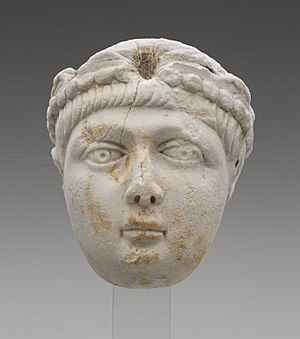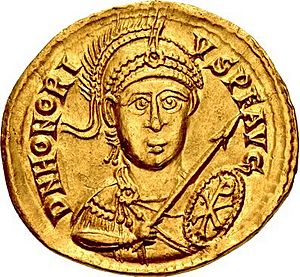Honorius (emperor) facts for kids
Quick facts for kids Honorius |
|
|---|---|
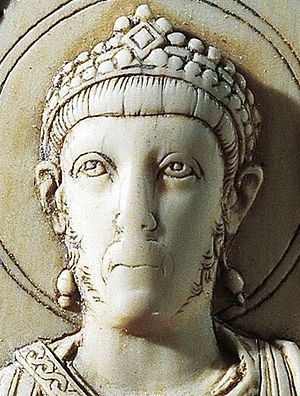
Detail of Honorius as depicted on the consular diptych of Probus, AD 406.
|
|
| Roman emperor (in the West) | |
| Augustus | 23 January 393 – 15 August 423 (senior from 17 January 395) |
| Predecessor | Theodosius I |
| Successor | Joannes |
| Co-rulers | Arcadius (East, 393–408) Theodosius II (East, 408–423) Constantine III (Gaul, 409–411) Constans II (Gaul, 409–411) Constantius III (West, 421) |
| Born | 9 September 384 Constantinople |
| Died | 15 August 423 (aged 38) Ravenna, Italy |
| Burial | Old St. Peter's Basilica |
| Spouse | Maria (m. 398, died 407) Thermantia (m. 408, divorced) |
| Dynasty | Theodosian |
| Father | Theodosius I |
| Mother | Aelia Flaccilla |
| Religion | Nicene Christianity |
Honorius (born 384, died 423) was a Roman emperor who ruled the Western Roman Empire from 393 to 423. He was the younger son of Emperor Theodosius I and his first wife, Aelia Flaccilla. After his father's death in 395, Honorius ruled the western part of the empire. His older brother, Arcadius, ruled the eastern part. Honorius's time as emperor was often difficult and full of challenges. In 410, the city of Rome was attacked and captured for the first time in nearly 800 years.
Contents
Honorius's Family Life
Honorius was born in Constantinople on September 9, 384. His parents were Emperor Theodosius I and Empress Aelia Flaccilla. He had an older brother named Arcadius. His mother died in 386.
His father later married Galla. Honorius gained a half-sister, Galla Placidia, from this marriage. Honorius, Arcadius, and Galla Placidia were the only children of Theodosius who lived to be adults.
Honorius Becomes Emperor
Early Years as Ruler
Honorius became a Roman consul at just two years old in 386. On January 23, 393, his father, Theodosius I, declared him Augustus, making him a co-ruler. This happened after the death of Valentinian II.
When Theodosius died in January 395, Honorius was only ten years old. He became the Western Roman Emperor. His brother Arcadius became the Eastern Roman Emperor.
During the early part of his rule, Honorius relied on a powerful general named Stilicho. Stilicho was part Vandal and part Roman. To make his ties with the emperor stronger, Stilicho married his daughter, Maria, to Honorius.
At first, Honorius's capital city was Milan. But in 401, the Visigoths, led by King Alaric I, invaded Italy. Honorius then moved his capital to Ravenna. This coastal city was safer because it was surrounded by marshes and strong walls. Ravenna remained the capital of the Western Roman Empire until 476.
Stilicho Defends Italy
Honorius's rule saw many attacks by barbarian groups into areas like Gaul, Italy, and Hispania. Many people also tried to take over as emperor.
The first big problem was a revolt in North Africa led by a general named Gildo. This revolt lasted two years (397–398). Stilicho eventually stopped it.
Then, in 402, the Visigoths under King Alaric invaded Italy. Stilicho quickly returned to protect Honorius. He gathered Roman soldiers from Gaul and Britain to defend Italy. Stilicho fought Alaric near Pollentia and later near Verona. The Visigoths were eventually allowed to leave Italy.
In 405, Stilicho faced another invasion of Italy, this time led by Radagaisus. Stilicho defeated them in 406. Around the same time, other tribes like the Vandals, Alans, and Suebi crossed the Rhine River and invaded Gaul.
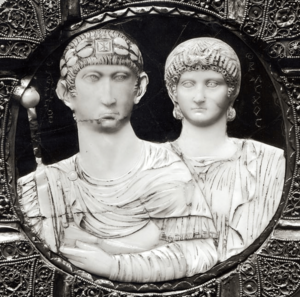
The situation in Britain was also difficult. The Roman provinces there were cut off and lacked support from the empire. By 410, Britain was told to manage its own defense.
In 408, Stilicho tried to make his position stronger by marrying his second daughter, Thermantia, to Honorius. This happened after Empress Maria died in 407. Stilicho also stopped another invasion by Alaric in 408. He convinced the Roman Senate to pay Alaric a large amount of gold to leave Italy.
However, a minister named Olympius convinced Honorius that Stilicho was plotting against him. When Stilicho returned to Ravenna, Honorius ordered his arrest and execution. After Stilicho's death, Honorius also punished Stilicho's allies and family. His wife, Thermantia, was sent away. Many of Stilicho's loyal troops then joined Alaric.
In October 408, Alaric returned to Italy. He wanted more gold and land. After a short siege, Rome paid him off with gold and silver. Later, Alaric forced the Roman Senate to choose Priscus Attalus as a new emperor.
The Sack of Rome
Rome had been under siege by the Visigoths since 408. In 410, the Eastern Roman Empire sent soldiers to help Honorius. However, Alaric attacked these soldiers on their way to Rome.
Honorius did not have a strong general to lead the Roman army. He decided to wait for the Visigoths to get tired. Many people criticized Honorius for this decision.
Rome depended on grain from North Africa. When the governor there, who was loyal to Honorius, stopped the grain supply, the people of Rome faced starvation. They blamed Attalus, the emperor chosen by Alaric. Alaric then removed Attalus as emperor and tried to talk peace with Honorius. But Honorius refused.
Because of starvation, someone opened Rome's defenses to Alaric. The Goths entered the city. Rome had not been captured by a foreign force in about 800 years. The attack itself was not as destructive as some other city attacks. For example, churches were mostly unharmed. But the event was a huge shock to the Roman world. It even inspired a famous book called The City of God by Augustine.
Challenges to the Western Empire
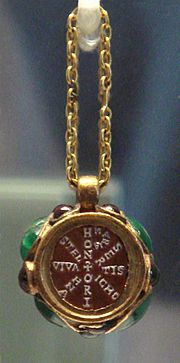
The revolt of Constantine III in the west continued during this time. In 409, one of Constantine III's generals rebelled against him. Honorius found a skilled commander named Constantius. Constantius defeated the rebels and Constantine III in 411.
Gaul continued to be a problem. After Constantius's troops returned to Italy, another person named Jovinus revolted in northern Gaul. Honorius made a deal with the Goths, and they helped him defeat Jovinus in 413.
In 414, Constantius attacked the Goths. They had again made Priscus Attalus emperor. Constantius drove the Goths into Hispania. Attalus was captured and removed from power again. Honorius punished Attalus by cutting off his right finger and thumb. He then sent Attalus to an island.
Northeastern Gaul came under more influence from the Franks. In 418, a treaty gave southwestern Gaul to the Visigoths. This meant the Roman Empire lost control over these lands.
In 417, Constantius married Honorius's half-sister, Galla Placidia. In 421, Honorius recognized Constantius as co-emperor, Constantius III. However, the Eastern Emperor, Theodosius II, did not accept him. Constantius died in September 421.
By the time Honorius died in 423, Britain, Spain, and Gaul had been badly damaged by barbarian groups. Later in his life, Honorius and his half-sister Galla Placidia had disagreements, leading her and her children to move to Constantinople.
Honorius's Death

Honorius died on August 15, 423, from a swelling illness called edema. He had no children. After his death, a man named Joannes was named emperor. However, the next year, the Eastern Emperor Theodosius II made his cousin, Valentinian III, the new Western Emperor. Valentinian III was the son of Galla Placidia.
Honorius was buried in the Mausoleum of Honorius on the Vatican Hill. His wife Maria was also buried there. This mausoleum was later turned into a church.
In 410, Honorius also responded to a plea from the people of Britain for help against barbarian attacks. Honorius was busy with the Visigoths and could not send military aid. According to a historian named Zosimus, Honorius told the cities in Britain to "guard themselves."
How Honorius Was Seen
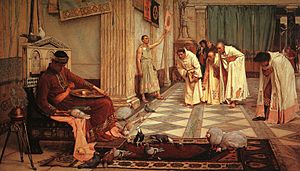
A story, probably not true, says that when Honorius heard that Rome had "perished," he was shocked. He thought the news was about his favorite pet chicken, which he had named "Roma." When he learned it was the city of Rome, he was relieved. This story, even if false, shows how some Romans viewed Honorius as foolish.
Some historians from the 19th and 20th centuries had a negative view of Honorius.
During his reign, Honorius made a rule that men in Rome could not wear trousers. The last known gladiatorial games happened during Honorius's time. He banned them in 399 and again in 404. This was reportedly because a Christian monk named Telemachus was killed while protesting a gladiator fight.
See also
 In Spanish: Honorio (emperador) para niños
In Spanish: Honorio (emperador) para niños
- Usurpers during Honorius reign:
- Priscus Attalus in Rome (two times, both as a puppet of Alaric);
- Maximus in Hispania;
- Marcus, Gratian, Constantine "III" and Constans "II" in Gaul and Britain;
- Jovinus and Sebastianus (joint puppets of Gundahar and Goar).
- Co-emperors with Honorius:
- Succession to Honorius:
- Joannes and Valentinian III.
- Ancient Rome: The Rise and Fall of an Empire


